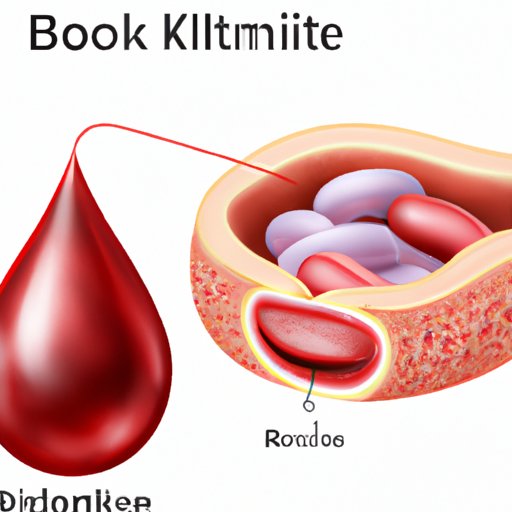
Introduction
Red blood cells are an integral component of our body’s circulatory system, responsible for transporting oxygen to various organs and tissues. Maintaining healthy levels of red blood cells is crucial because a deficiency can lead to anemia and other serious health issues. Fortunately, there are many ways to increase the production of these vital cells naturally, from incorporating specific foods into your diet to developing healthy habits. In this article, we’ll guide you through the process of increasing your red blood cells, and ultimately boosting your overall health.
Foods That Increase Red Blood Cells
Certain types of food are rich in the nutrients needed for the production of red blood cells, including iron, B-vitamins, folate, and Vitamin C. Incorporating these foods into your diet can help to increase your red blood cell count. Foods rich in iron include dark leafy greens, red meat, and seafood. Liver, eggs, and whole grains are also good sources of B-vitamins. Folate-rich foods include beans, lentils, and spinach, while Vitamin C can be found in citrus fruits, berries, and vegetables like peppers and broccoli. By incorporating a variety of these foods into your meals, you can boost your red blood cell count naturally.
Vitamins and Supplements
In addition to incorporating the right foods into your diet, taking vitamin and mineral supplements can also help to increase red blood cell production. Vitamin C supplements can help to increase the absorption of iron from foods, making it more available for the production of red blood cells. Iron supplements are also a common option for those with anemia or other deficiencies. Vitamin B-12 supplements can boost red blood cell counts by supporting the production of healthy red blood cells. However, it’s best to consult with a healthcare professional before starting any new supplement regimen for guidance on dosage and potential side effects.
Developing Healthy Habits
Developing healthy habits is a great way to increase your red blood cell count naturally. Regular exercise can help to stimulate the production of new red blood cells, so it’s important to incorporate physical activity into your routine. Drinking plenty of water and maintaining a nutritious diet will also support the production of red blood cells. Ensuring that you get enough sleep each night is also crucial for overall health, including the healthy production of red blood cells.
Iron, B-Vitamin, and Folic Acid-rich recipes
Here are three delicious and easy-to-make recipes that are rich in nutrients needed to increase red blood cell production:
Recipe 1: Spinach and Feta Stuffed Chicken Breast
Ingredients:
• 2 boneless, skinless chicken breasts
• 2 cups fresh spinach leaves
• 1/2 cup crumbled feta cheese
• 2 tablespoons olive oil
• Salt and pepper to taste
Instructions:
1. Preheat oven to 375F.
2. Slice a pocket into each chicken breast.
3. Stuff the pocket with spinach and feta cheese.
4. Season with salt and pepper.
5. Heat olive oil in a skillet over medium heat.
6. Brown the chicken on all sides, about 3 minutes per side.
7. Transfer the chicken to a baking dish and bake for 20-25 minutes until fully cooked.
Recipe 2: Beef and Lentil Soup
Ingredients:
• 1 lb. beef stew meat
• 1 cup lentils, rinsed
• 1 onion, chopped
• 2 cloves garlic, minced
• 1 teaspoon paprika
• 1 teaspoon dried thyme
• 1 bay leaf
• 6 cups beef broth
• Salt and pepper to taste
Instructions:
1. Brown beef in a skillet over medium heat.
2. Add onion and garlic, and sauté until softened.
3. Transfer beef and onion to a large pot.
4. Add lentils, paprika, thyme, bay leaf, and beef broth.
5. Bring to a boil, then reduce heat and simmer for 45 minutes, stirring occasionally.
6. Remove bay leaf and season with salt and pepper to taste.
Recipe 3: Mixed Berry Smoothie
Ingredients:
• 1 cup mixed berries (fresh or frozen)
• 1 banana
• 1 cup almond milk
• Handful of spinach
Instructions:
1. Combine all ingredients in a blender or food processor.
2. Blend until smooth and enjoy cold.
Common Symptoms and Conditions
Low red blood cell count can result in anemia, which can cause a range of symptoms including fatigue, weakness, shortness of breath, chest pain, and dizziness. Those with low red blood cell counts may also experience pale skin, irregular heartbeats, and frequent headaches. If you’re experiencing any of these symptoms, it’s important to talk to your doctor to determine the cause and the best course of action.
Medical Treatments Available
For those with low red blood cell counts, there are a number of medical treatments available. Prescription medication can be used to treat conditions that cause low red blood cell production such as chronic kidney disease. Blood transfusions may also be used in certain cases. In severe cases, a bone marrow transplant may be necessary. However, these treatments may have side effects, so it’s crucial to consult a medical professional for advice on the best course of action.
Conclusion
Incorporating the right foods into your diet, taking supplements, and developing healthy habits can all help to increase red blood cell production and overall health. By making these small changes, you can support the vital work of these tiny but incredibly important cells, and enjoy better health and vitality as a result.





